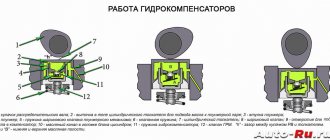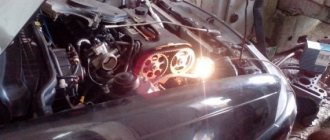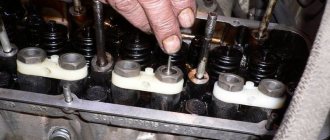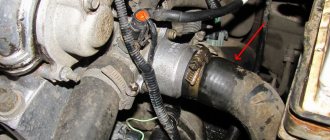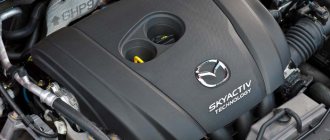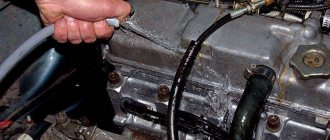In this article we will try to carefully consider all the features of checking hydraulic compensators. This element of the car is a hydraulic mechanism, thanks to which the optimal clearance in the valve mechanism is established when exposed to high temperatures. When a car engine heats up, parts increase due to natural processes, which is the main reason for the reduction in gaps between them. The main task of the hydraulic compensator is to maintain the optimal clearance between the valve and the camshaft as the engine temperature changes.
A serviceable hydraulic compensator works efficiently and does not make any extraneous noise. The appearance of a knock may indicate wear of the mechanism. Increasing clearances leads to a decrease in engine power, accelerated valve burnout and increased fuel consumption.
Why are hydraulic compensators knocking?
A hydraulic compensator is a device responsible for automatically adjusting the thermal gap in a separate valve. Thanks to their use, engine operation becomes easier. The reason is that you don’t have to adjust the valves manually. They also increase the service life of the gas distribution mechanism. It functions more evenly because the thermal gap is always within the manufacturer's tolerances.
But it happens that the hydraulic compensator starts knocking. Over time, the knocking becomes stronger and becomes impossible to ignore. Often there are three reasons.
- Severe natural wear and tear or manufacturing defects in design.
- The engine lubrication system operates intermittently.
- The engine oil is not compatible with the engine, or it has been used for too long, as a result of which it has lost its original properties.
The driver must remember that the compensator is capable of knocking not only constantly, but also in a certain engine operating mode.
In the cold
If the hydraulic lifters start knocking when cold, check which of the following is true.
- The oil is too thick. If the engine is not brought to the operating temperature range, the lubricant will begin to poorly penetrate into the cavities of the hydraulic compensator. To ensure that the cavity collects enough oil, you need to wait a little.
- The timing valve contains too much dirt. Solid particles appear if the engine oil has too many harmful impurities, or the owner delays the timing of lubricant changes. Also, the presence of debris indicates the release of wear products from some engine parts.
- Plunger jamming or severe mechanical wear. Most often, the cause is the penetration of abrasive particles into the oil structure.
Hydraulic compensator device
In total, there are 2 types of hydraulic compensators, each of which is divided into 2 more subtypes: hydraulic pusher (regular or roller), hydraulic support (regular or for installation in a lever or rocker arm). The design will depend on which timing gear the part will work in tandem with: DOHC or SOHC. In general, a hydraulic compensator is a hydraulic plunger system in a non-separable metal housing. The main elements of such a system are:
- Plunger pair (plunger and bushing);
- Plunger spring;
- Check valve (usually a spring-loaded ball);
- Frame.
The installation location of hydraulic compensators depends on the type of timing belt. In the case of DOHC these are the valve head wells, and in SOHC these are the valve rocker chambers. An ideally functioning compensator prevents the occurrence of gaps throughout the entire timing cycle. The prefix “hydro” is placed in the name for a reason, since the operation of the device depends on changes in engine oil pressure. It is not entirely correct to compare a hydraulic compensator with a spring, but this analogy makes sense. We suggest you familiarize yourself with the two main phases of the device’s operation:
- The timing valve is closed. Since the camshaft cam does not act on the compensator, the spring inside its housing is completely relaxed and lifts the plunger as much as possible, pressing it against the cam. In this case, the sub-plunger space is completely filled with engine oil and the lubricant pressure inside the compensator is equalized with the pressure in the oil system;
- The timing valve is open. The camshaft cam is turned towards the compensator and has maximum impact on it. The spring of the device is selected so that its force is sufficient to open the timing valve. Excess oil is then pushed back into the lubrication system.
Thanks to the presence of a correctly selected spring, the hydraulic compensator prevents the occurrence of gaps both in both of these phases, and during the transition from one phase to another, when, for example, the valve just begins to open or close. More importantly, the compensator continues to work normally even when the cams wear out and their cast length becomes shorter than normal. Simply put, the device “selects” the gap based not only on thermal expansion, but also on the wear of the timing elements.
How to determine which hydraulic compensator is knocking
Detecting a worn or failed element does not take much time. To do this, you need to remove the cylinder head (cylinder head) from the engine to partially gain access to the internals. This is enough for diagnosis.
To check, you need to take a wooden block. You need to make sure that it is not too thick.
The essence of the test comes down to pressing a block on the bottom of the hydraulic compensator. When excessive force is applied, it causes it to sink into the seat.
Note! When checking, make sure that the bottom does not interact in any way with the camshaft cam. If this happens, it means there is a lot of wear on the camshaft cam - it should be replaced.
If the hydraulic compensator jams, the created forces will not allow it to hide inside the seat. A person will not be able to press with such force to overcome the resistance of the valve spring.
If there is no oil for any of the reasons listed earlier, the hydraulic fluid will sink into the seat even with minimal pressure on the wooden block. So that the engine does not have to be sent for major repairs, the compensator should still be replaced.
In this simple way you can determine in which compensator the knock appears.
Replacement and repair
It is highly not recommended to repair these devices, restore the gap, or blow it out on your own. Experts advise replacing the parts with new ones. Moreover, they are relatively inexpensive.
So, first you need to remove the decorative trim of the engine. Next, the receiver is removed. All intake ports are sealed with a piece of clean rags to prevent dirt from subsequently entering the combustion chamber. Then the ignition module and crankcase ventilation hose are dismantled. After this, unscrew the bolts of the injector power wire bracket. If it is a 16-valve engine, 15 valve cover bolts are unscrewed. It should be placed in a clean place to prevent dirt from getting into the oil in the future. After this, hydraulic compensators are visible in front of us. To check the functionality of each, you will need a screwdriver. By smoothly pressing the top of the element, we check the movement of the piston. A working element is compressed with great force. If you do not have to press hard to do this, the hydraulic compensator has failed and needs to be replaced. The drive gears are removed from the camshaft (there are two on a 16-valve engine), and the oil pressure sensor is turned off. Unscrew the mounting bolts of the bearing housing and the nuts of the rear camshaft support bracket.
Then remove the support along with the spark plug guides. We take the camshafts out (they will be installed back according to the marks) and put them in a clean place. Using a magnet, remove the hydraulic compensator and pusher. We install a new element in its place. Assembly should be done in reverse order, taking into account the marks of the camshafts. After such repairs, the knocking of hydraulic compensators will definitely be eliminated.
So, we found out what this mechanism is, how it works and how to replace it with your own hands.
What to do if hydraulic lifters are knocking
If hydraulic compensators start knocking, what should you do in this case? There are two ways to solve the problem - complete replacement of the kit or repair of defective units. Let's consider each of them separately.
Replacement
The advantage of replacement is a guarantee of a good result. There are two disadvantages. A set of original catalog parts will be expensive. It is unlikely that you will be able to install it correctly yourself, so the car will have to be sent to a service center. Here you will also have to wait two or three days.
It must be taken into account that some foreign-made machines are subject to a shortage of parts. You have to wait for the complete set to arrive, spend money on postage, and make an appointment for repairs at a service center. For proper installation, you will also have to allocate some money for disposable parts - sealant and gaskets.
If the case is advanced and the driver does not try to take action to restore normal operation of the engine, the consequences can be dire. At first, when starting up, the knocking noise gets stronger over time. Then the smooth idle speed disappears. Since the thermal gap is not adjusted properly, it becomes more difficult to gain momentum each time. Ultimately, the entire valve mechanism wears out, and engine repair becomes inevitable.
Repair
To quickly troubleshoot the problem, you must first find out which compensator is starting to knock. Repair is possible if the malfunction begins to manifest itself when cold. If you regularly use high-quality lubricant and replace it in a timely manner, you just need to buy original oil, change the filter and check the result again. Most likely, the owner, without realizing it, bought a fake canister.
At the initial stage, it is also worth buying flushing oil. Along with it you will have to acquire two filters. One is used when pouring flushing material, the other must be screwed on when the technical fluid has had time to circulate through the system in 15-20 minutes of idle operation. For special cases, you will need an aggressive composition. For example, pharmaceutical dimexide. Its chemical structure contains hard elements that are capable of removing soot and other deposits, regardless of their thickness.
Main types of faults
We answer the question of how to check hydraulic compensators for functionality. It can be noted that there are four reasons for the occurrence of malfunctions:
- Increasing the size of the gaps in the areas indicated by the arrows in the photo below. Gaps are formed between the plunger and the plunger bushing. The result will be increased oil leakage. The compensator simply will not have time to “select” the thermal gap;
- In rare cases, the check valve does not close tightly. Which, at a minimum, makes it impossible to create sufficient pressure generated between the sleeve and the plunger;
- The bushing should move freely relative to the plunger. In the areas indicated in photo 3, a blockage may appear, and then the plunger pair jams;
- Clogged engine oil passages are another reason why compensators stop working.
This is interesting: Generator for Volkswagen Passat B3: technical features
The first failure always occurs as a result of abrasive wear. If you use low-quality oil, you will get the appropriate result. The second malfunction is the result of wear or clogging. The latter, by the way, is more common. Well, jamming can occur due to gradual coking or due to the appearance of deposits.
Each of the reasons received a number from 1 to 4. Next, links are made that say which reason causes this or that effect. Read carefully.
Consequences if hydraulic compensators knock
Interestingly, failure of the hydraulic compensator is not a direct cause of damage to other engine components. Knocking compensators only lead to a violation of the thermal gap, which results in a decrease in throttle response and engine power. Consequently, fuel consumption increases.
Perhaps knocking sounds indicate poor performance of the oil system. Here you will have to take the car to a service center for diagnostics, so that the technicians can determine the cause of the knocking noise and eliminate it, taking into account the manufacturer’s requirements.
In the case of DOHC and SOHC gas distribution systems, they differ only in the number of hydraulic compensators present inside the engine. But if you do not take the car for service and use it every day in this condition, an increase in fuel consumption will lead to increased wear on the grinding elements. Therefore, it is better to diagnose hydraulic compensators in advance, so that later you do not have to carry out major engine repairs.
Checking functionality
As we have already noted, this part can easily fail due to violation of operating rules. However, it is quite possible to prevent further destruction of the motor, and this does not require special tools and equipment. By what signs can you determine if they are broken? The knock of the hydraulic compensators is the first “bell” indicating that a breakdown has occurred with the part.
If a characteristic “clattering” sound occurs during operation at idle, it means that one of the elements has become unusable - clogged or simply expired.
How to identify a faulty hydraulic compensator
Domestic cars tempt car owners with their ease of repair. Most service and repair work can be carried out independently, without contacting a service station and significantly saving the family budget. But before proceeding directly to the repair, you need to correctly diagnose the cause of the malfunction.
Using a Chevrolet Niva car as an example, we will tell you how to find out which hydraulic compensator is knocking on the engine timing belt.
Checking the knocking hydraulic compensator
You can first determine which hydraulic compensator you need to work closely on in a simple way. Those hydraulic compensators that are set at top dead center need to be lightly pressed down with a screwdriver, which is used as a lever.
If the hydraulic compensator “falls” under light pressure, it means that it is not adjusted and makes a knocking noise. You can even, for the “purity of the experiment,” quickly press the screwdriver lever and tap the hydraulic compensator.
This is where the marks are located on the motor.
After checking the hydraulic lifters alone, rotate the camshaft sprocket 180° so that the crankshaft rotates 360° accordingly. And proceed to check the next group. “Correct” hydraulic compensators “stand still” and do not respond to light pressure from a lever screwdriver.
After first identifying out-of-adjustment hydraulic lifters, make sure there is no error. This is easy to check; there is an old, “old-fashioned” method. After removing the camshaft box cover, press the “loose” hydraulic compensators with your finger. If there is no error, then they will press easily.
Something else useful for you:
Adjusting hydraulic compensators does not always give the desired result. It happens that they turn out to be very worn out, and adjustment is simply not enough. The solution in this situation is to replace them with new ones.
After adjusting or replacing hydraulic compensators, check the operation of the motor. To do this, you need to start it. After starting the engine, a knocking noise is heard for some time. Don’t be alarmed right away; the hydraulic compensator must “bleed.” If everything went correctly, the knocking will soon stop.
To be on the safe side and finally make sure that everything was done correctly, turn off the engine. Wait a little and start it again, the knocking should not happen again. If we didn’t hear a knock, then the “bad” hydraulic compensators were identified correctly.
No matter how far the automotive industry has advanced, no matter how many electronic devices that detect car breakdowns have been invented, we often use old, proven, “old-fashioned” diagnostic methods for domestic cars. They are much more affordable, do not require expensive equipment and are not inferior in accuracy to innovative methods.
And when applied to domestic automotive equipment, which is often produced using outdated technologies, the “old-fashioned” methods of diagnosing cars are the most correct and accessible to ordinary car enthusiasts.
Approximate price of hydraulic compensators
Unlike foreign-made cars, parts for the VAZ-2112 are affordable. In most auto parts stores for domestic cars you can find a set of hydraulic compensators for a sixteen-valve engine at a low price - about two thousand rubles. Before purchasing, carefully examine each pusher to avoid purchasing a defective part.
Among manufacturers of spare parts for VAZ-2112 engines, the INA brand occupies a leading position, but it is very often counterfeited. In order to make the right choice, watch a video in advance about the features of branded hydraulic pushers. Pay close attention to how much a set of pushers costs, since a high-quality spare part cannot be cheap.
Sources
- https://FB.ru/article/461780/gidrokompensator-vaz—naznachenie-harakteristiki-vozmojnyie-problemyi-i-sposobyi-resheniya
- https://MasteraVaza.ru/dvigatel/obsluzhivanie-dvigatelya/zamena-gidrokompensatorov-vaz-2112-422
- https://AutomobilGroup.ru/instruktsiya/zamena-gidrokompensatorov-foto-instruktsiya-pomenyat-gidrokompensatory/
- https://automotogid.ru/kak-razobrat-gidrokompensator-vaz-2112/
- https://pricep-vlg.ru/remont-svoimi-rukami/kak-proverit-gidrokompensatory/
- https://topmekhanik.ru/kak-samostoyatelno-razobrat-i-promyt-gidrokompensator/
- https://autorn.ru/vaz/2110/436-zamena-gidrokompensatorov-vaz-2110-2111-2112.html
- https://l2rv.ru/info/kak-proverit-kompensatory-vaz-2112/
- https://ladaautos.ru/vaz-2112/remont-vaz-2112-16-klapanov-zamena-gidrokompensatorov.html
[collapse]
Why do hydraulic compensators knock?
Hydraulic compensators regulate the thermal clearance of the valves and maintain it in proper condition when the engine is cold and warm. If noise appears, this does not indicate a faulty part. The reasons may be different:
- use of low-quality motor oil;
- malfunctions in the lubrication system of the power unit;
- mechanical wear of the main body.
The tapping occurs no matter how warm the unit is. This negatively affects the service life of the cylinder head, and other malfunctions may occur. When the hydraulic fluid is operating, contamination and defects appear on their surface, due to which the valve responsible for the oil intake hangs - the component simply stops working.
Air may enter the engine lubrication system due to lack of oil. Air has a negative impact on the level of oil compression, and it can appear in the system not only due to a lack of working fluid, but also due to its excess. Excess oil foams up in the oil pump, causing air to appear inside the system.
Let's look at specific situations and find out all the possible reasons for the knocking of hydraulic compensators.
Hot
Surely the problem is in the engine oil. It is the hydraulic fluid that primarily reacts to the presence of low-quality working fluid in the system. After changing the oil the knocking noise will disappear.
The problem may be that the oil filter is dirty, as a result of which dirt gets into the hydraulic compensator. If the engine oil is filled out of season, if the fluid viscosity does not meet the standards, this can also cause knocking. Deterioration in the properties of the lubricant occurs due to the ingress of antifreeze into it.
The source of the problem may be the oil pump. It must create the required pressure. If this does not happen, the oil stops flowing into the HA. The working fluid flows through the gaps between the sleeve and the plunger. I have to change the hydraulic compensator.
In the cold
The knocking sound of the engine can appear on a cold engine and disappear as the engine warms up. Then the most likely reason is a clogged oil channel. After warming up, the oil will become more liquid and the knocking will stop. But over time, the channels will definitely become completely clogged, and then the knocking will be continuous. Here you can use special additives - they will help clean the channels from accumulated contaminants.
The knocking of hydraulic compensators when cold is also due to a decrease in the throughput of the oil filter. Then knocking with varying intensity will be heard until the engine is completely warmed up.
Pay attention to the hydraulic compensator valve - if it does not hold oil, liquid will leak out when the engine is turned off.
Thus, air enters the system, which is forced out after starting the engine - the knocking disappears. Wait 5-7 minutes. Sometimes it is useful to rev the idle speed - this will increase the pressure in the oil supply system. But it is harmful to gas for a long time. It is better to do this only when the warmed-up engine has been stopped for a while.
New
How to check hydraulic compensators for functionality and their malfunctions
The hydraulic compensator is a part that is located in the cylinder head and performs the function of automatically adjusting the valve clearance. Depending on the make and model of the car, as well as the type of engine, their number may vary. Hydraulic compensators eliminate the need for manual valve adjustment. But, like any parts, they can develop malfunctions. The usual symptom is a loud knocking sound. If the car owner heard it, then it is necessary to take timely measures to avoid more serious consequences. It’s worth figuring out why hydraulic lifters are knocking and how to fix it.
Causes of knocking hydraulic compensators
Hydraulic compensator device
Hydraulic compensators knock due to improper functioning when the required oil pressure is not created in them. This can happen for various reasons:
Hydraulic compensators knock due to improper functioning when the required oil pressure is not created in them.
- wear of the plunger pair;
- jamming of the hydraulic compensator in a compressed state due to burnt oil;
- contamination with scale, scale, flakes of burnt oil, and other foreign objects in the oil channel, both in the hydraulic compensator itself and in front of it;
- foreign body getting under the ball valve.
Diagnostics of the hydraulic compensator
Sometimes a situation arises when hydraulic compensators knock when cold. The reasons for this problem may be as follows:
Failure to match the recommended oil grade is often the cause of hydraulic lifters knocking when cold.
- oil viscosity does not match the recommended one;
- pressure reducing valve malfunction;
- worn out or faulty hydraulic compensator;
- oil filter not replaced on time or clogged;
- low engine oil level;
- penetration of other liquid into the oil;
- untimely oil change.
It is also a fairly common problem if hydraulic compensators knock when hot. This occurs due to the following factors:
- the type of oil does not match the current season, since in the summer, winter oil becomes more liquid;
- hydraulic compensator malfunction, damage, wear;
- lack of required pressure in the oil system due to a clogged filter, oil pump or faulty pressure relief valve.
What to do if hydraulic lifters are knocking
Checking the oil level
Low oil level is a fairly common cause of knocking hydraulic lifters.
If a characteristic knocking noise occurs under the hood, you must first understand the reasons in order to eliminate the problem. First of all, you need to check the oil level in the engine, while turning it off for at least 2-3 minutes. Low oil levels can greatly affect the operation of hydraulic lifters, and this is a fairly common cause of knocking. If this problem is detected, then it is necessary to add oil to the engine to the required level. If the oil level is normal, you need to remember how long ago it was changed. If too much time has passed since the oil change, this may also affect the hydraulic lifters. In this case, it is necessary to change the oil and flush the engine.
If problems with oil are excluded, then the problem may lie in the condition of the hydraulic compensators themselves.
How to check hydraulic compensators for functionality, repair them or replace them
Checking the performance of hydraulic compensators
To check the hydraulic compensators, you need to remove the valve cover and check the elasticity of the hydraulic compensator with your hands.
The hydraulic compensators are checked by penetrating under the valve covers and turning the crankshaft by the central nut. Due to the drive of the gas distribution mechanism, the camshaft begins to rotate. At those moments when the cams of the pushers are directed in the opposite direction from the hydraulic compensator, an alternate check for elasticity and the presence of free play begins. This can be done either by hand or with a special tool. If the hydraulic compensator is soft or loose, then it is necessary to begin repairing it.
Features of repair of hydraulic compensators
After removing the hydraulic compensator, it is necessary to wash it in clean gasoline, diesel fuel or kerosene, or in a special washing liquid that breaks down carbon deposits and fats. It is necessary to lower the part there, rinse and wipe. You need to find a hole and use a metal object suitable for its diameter to press it to open it. During this, the hydraulic compensator should be lowered into the liquid so that it penetrates inside. It is necessary to repeat these steps several times.
Disassembling and cleaning hydraulic compensators
After cleaning the hydraulic compensators, they must be lubricated with oil before installation.
Through the same hole you need to get rid of the flushing fluid and excess air, while simultaneously clamping the hydraulic compensator itself. After this it should press freely. After washing the hydraulic compensator, you can put it back in place if there are no visible defects. It must be lightly oiled before installation. Next, the part is installed in the reverse order of removal. After this, you need to start the car and assess the situation. If the knocking continues, then repairing the hydraulic compensators will no longer help, you need to replace them. Also, if after removing the hydraulic compensator it is discovered that there is damage on it, then the part must also be replaced with a new one. To replace hydraulic compensators, you should purchase a suitable part from the store and install it in place of the old one.
Of course, many car enthusiasts are interested in the question of how much it costs to replace hydraulic compensators. It is impossible to answer this question unequivocally. The final amount depends on the number of standard hours spent on this procedure. Also, do not forget that the cost of parts for different cars varies.
How to bleed hydraulic compensators and why it is needed
After installation, the hydraulic compensators must be “bleeded” with the engine running to remove trapped air.
After new hydraulic lifters have been installed, a knocking noise may be heard. This does not mean that the parts are faulty. You just need to “bleed” it to remove any trapped air. To do this you need to start the car. The engine should run at 2500 rpm for approximately three minutes. You can increase the number of revolutions to 3000. At idle speed, you need to let the engine run for 30-40 seconds. After this, the engine is turned off for a minute. Then it starts up again, and if knocking is heard again, then the cycle of actions must be repeated.
Is it possible to drive if the hydraulic lifters are knocking?
It is not recommended to continue operating the vehicle with knocking hydraulic compensators. This can lead to much more serious problems. Malfunctions of hydraulic compensators can lead to loss of engine power, increased fuel consumption, burnout of valves, rapid wear of parts and even jamming of the unit. Therefore, it is necessary to check the situation in time in order to clean the hydraulic compensators or replace them.
Liqui Moly additive for hydraulic compensators: is it worth using?
Oil additive Stop noise of hydraulic compensators Liqui Moli
If, after changing the oil, the hydraulic compensators begin to knock, you can use the Liqui Moly Stop Noise additive.
The modern manufacturer Liqui Moly produces a special additive for engine oil, which allows you to get rid of the noise of hydraulic lifters, which occurs due to insufficient lubrication. The substances contained in the stop noise additive for Liqui Moly hydraulic compensators allow you to clean oil channels even in hard-to-reach places. The lubricating properties of engine oil improve, its viscosity increases, which helps get rid of noise. This additive can be used if the hydraulic compensators start to rattle after changing the oil.
Thus, the hydraulic compensator is an important part in the car, which ensures the correct operation of the engine. The car owner must understand that when a knocking noise occurs, it is necessary to immediately begin to look for its causes. If you can’t find out on your own how to identify a knocking hydraulic compensator, then you should contact a car service center. There, specialists will quickly determine the causes and fix the problem. Sometimes it is possible to eliminate the knocking of hydraulic compensators without disassembling them, but in some cases they will require replacement or repair.
Read on topic:
mytopgear.ru
Consequences of knocking hydraulic compensators
If there is a knock, of course, you should not completely stop using the vehicle. But there can be negative consequences:
- Fuel will begin to be consumed much more actively.
- The power of the power unit will be reduced.
- The engine will not rev as quickly as before the problem occurred.
- The vibration will increase.
- The timing life will be reduced.
Noise is one of the symptoms of a motor malfunction, which means repairs need to be carried out as quickly as possible.
Hydraulic compensators are knocking: what to do?
Before fixing the problem, you need to identify the knocking expansion joint. Otherwise, you can repair something that already works great.
How to determine which hydraulic compensator is noisy
To check the HA you need to press on it with a screwdriver. In this case, the camshaft cam should be turned towards the pusher with its back side. If the hydraulic pusher is in working condition, you will have to apply force to press it. If it runs freely, there is a malfunction and needs to be replaced.
Now we install the camshaft cams one by one with the protrusions facing upward and check the gap between them and the pushers. We recess the hydraulic pusher to be checked using a wooden wedge and compare the speed of its movement with others. If the speed is higher, it needs to be cleared of blockages.
Solutions to the problem
First try completely changing the oil in the system. It is also better to change the filter to a new one. If immediately after replacing the working fluid the hydraulic fluid still rattles, there is nothing to worry about - not all channels have yet managed to fill with oil. After a while the noise should stop. It is very important to use the oil recommended by the manufacturer.
If the problem is not solved, you can try to restore old HAs - they need to be thoroughly washed with kerosene to remove contaminants on the plungers. After washing, we put it back in place and check for noise. Each element must be installed strictly in its place; they must not be confused. If the noise continues, the only option is replacement.
Instructions for restoring the performance of hydraulic pushers
To access the hydraulic compensators, you will need to partially disassemble the gas distribution mechanism. The simplest test is to press the device with your finger - it should remain as rigid as possible. If the pressure causes the pusher to “fall through”, then the assembly is removed and washed. To do this, we suggest using the recommendations.
This is interesting: Correct valve clearances for VAZ 2108: checking and adjustment
Required spare parts
Article numbers 2112-1007300-01 and 2112-1007300 indicate hydraulic pushers manufactured by AvtoVAZ - this is the catalog number. They need to be purchased for repairs. The price of the set is about 3,300 rubles (per piece – 220 rubles). You can also buy spare parts with article number 420007310 INA. They are suitable for replacing VAZ 2112 hydraulic compensators (16 valves), but the price of the set is higher - up to 2,700 rubles (per piece - 280 rubles). Another analogue is Herzog HL0 7300. Price 2700 rubles. The compensator Master-sport 2112-1007300-SET/16/-MS is also recommended for installation on VAZ 2110, 2111, 2112.
Tools required for repairs
To work you need to prepare the following tool:
- magnetic screwdriver;
- jack;
- a set of keys;
- rags;
- sealant or degreaser.
Independent replacement of VAZ 2110 hydraulic compensators 16 valves is completely justified economically. In car services, as of July 21, 2019, the price of repairs averages 3 thousand rubles. In addition to money, you will save personal time.
Sequence of operations
To replace the hydraulic compensators of the VAZ 2112 and other models, you need to drive the car into an inspection hole, drive onto an overpass, or lift it with a jack. It is important to ensure reliable fixation of the vehicle and sufficient illumination of the work area. Now you can start working:
- For safe work, you need to turn off the on-board power supply; to do this, disconnect the negative terminal from the battery.
- Removing the plastic engine shield - unscrew the four bolts.
- Now you need to loosen the mount of the generator on the mounting plate; to do this, loosen the nut.
- You need to remove the generator drive tension belt. To do this, loosen its tension by rotating the nut counterclockwise.
- Removing the engine intake manifold and receiver. The hole must be closed to prevent dirt and foreign objects from getting into them.
- Then you need to dismantle the right wheel and the plastic shield covering the engine compartment. Now use the pulley bolt to turn the crankshaft clockwise.
- The lower pulley rotates to the camshaft timing pulley mark to the antennae on the rear timing cover.
- The camshaft pulley fastenings are loosened and the timing belt is removed.
- To completely dismantle the camshaft pulleys, you need to check the marks on the timing belt housing. They must line up exactly with the marks on the pulleys.
- Using the heads, 15 fasteners of the cylinder head cover are unscrewed.
- Now twenty fasteners of the camshaft bearing housing are unscrewed.
- The camshaft bearing housing is removed.
- The camshaft is completely removed, along with the seals.
- A magnetic screwdriver is applied to the end of the hydraulic pusher, so it is removed from the head socket.
- New spare parts are installed in place of the old compensators in the cylinder head sockets.
- The cams and bearing journals are lubricated with oil, the shafts are installed in the head supports. Note! To easily distinguish the intake camshaft from the exhaust device, there is a belt on its first journal.
- Now you need to tighten the nuts until they touch the cylinder head of the bearings. The operation is performed in a certain sequence, it is shown in the figure.
- The valve cover, timing belt and pulleys are returned to their original locations. Further operations are performed in reverse order.
For the sequence of replacing hydraulic compensators on the VAZ 2110 and other models, watch this video:
What to do if hydraulic lifters are noisy?
The article is about what measures need to be taken if hydraulic compensators are noisy - the reasons for the knocking, methods for eliminating the problem. At the end of the article there is a video about what to do if hydraulic lifters are knocking.
If the gaps are not adjusted properly, then the valves in the timing belt will also close incorrectly, as a result of which they will burn out and a knock will appear. In addition, the size of the gaps may change if the timing mechanisms are heavily worn during operation. Since adjusting valve thermal clearances is a rather complex and responsible task, hydraulic compensators began to be used instead of levers and washers that require complex adjustments.
A hydraulic compensator (hydraulic pusher) is a small mechanism that automatically adjusts the thermal clearances of timing valves
, without any additional settings. This miniature mechanism automatically changes the gaps to the desired size under the influence of a spring and engine oil pressure.
Purpose of hydraulic compensators
Before talking about the purpose of the above-mentioned car component, it is worth understanding which unit it is an element of. We are talking about the gas distribution mechanism, and we will further shorten this name to timing. The main elements of the mechanism include:
- Camshaft;
- Valves (inlet and outlet);
- Valve pushers;
- A camshaft pulley that receives torque via a belt drive.
The essence of the timing is to ensure synchronous rotation of the camshaft and crankshaft, in which the cams alternately press on the rocker arms (in the case of V-shaped internal combustion engines) or pushers, which, in turn, push the valves. As the engine operates, a large thermal valve gap forms between the shaft cam and the timing element responsible for interacting with the valve. Hydraulic compensators were created to compensate for this - they cope with this work more than efficiently, and most importantly automatically, i.e. without the direct intervention of the car owner. In the past, gap adjustment was carried out using hand tools using specially marked marks. It is noteworthy that in the engines of old cars it was necessary to adjust the gaps approximately every 40-50 thousand kilometers.
The consequences of incorrectly adjusting the clearances or completely ignoring them are disastrous: a drop in compression, gas breakthrough into the passages, accelerated wear of valves (especially exhaust valves). The engine will lose power and start running more noisily. The wear of some of its components will catastrophically accelerate, which will ultimately result in expensive repairs. The normal thermal clearance is a fraction of a millimeter, but it is worth noting that the values are different for exhaust and intake valves. When purchasing used car, it is important to determine the size of the gaps, as well as make sure that the hydraulic compensators are in good working order, if the vehicle is equipped with them.
Why do hydraulic compensators make noise (knock)
"Oil" problem
The correct operation of hydraulic compensators greatly depends on such oil factors as:
- quality, freshness, and compliance with engine manufacturer recommendations.
- level.
- pressure.
The use of low-quality motor oils, as well as long-term operation of the engine with old (used) oil, leads to the accumulation of carbon deposits, which begins to impede the movement of the moving elements of the compensator. In addition, the cylinder head channels and hydraulic compensator holes become clogged.
When the engine oil level exceeds the norm, it foams in the crankcase and loses its homogeneity.
, with subsequent changes in indicators: viscosity, thermal conductivity and lubrication. The speed of oil passage through the channels depends on the viscosity, which directly affects the operation of the hydraulic compensators - after all, if the oil thickens strongly, the channels can become clogged, and the liquid will stop flowing (or will begin to flow more slowly) into the compensators.
On the other hand, if the oil is very thin, the pressure in the oil system may drop, and the oil will also flow poorly into the compensators. And when the oil level in the engine is below normal, the oil pump sucks in air when delivering fluid to the compensators, which also negatively affects their operation and leads to knocking at high engine speeds.
Insufficient oil pressure may be due to a faulty pump
, as a result of which oil will be pumped into the hydraulic compensator slowly or not delivered there at all. In addition, a decrease in pressure inside the compensator can occur due to oil dilution or clogging of the oil channels of the hydraulic compensator itself.
Wear and mechanical damage
Design and principle of operation of hydraulic compensators
In domestic cars, the design of a hydraulic compensator in the valve drive mechanism is relatively simple. Outwardly, it resembles a piston. Its upper part is under pressure from the eccentric or camshaft pusher. There is a groove and a hole on the side wall through which oil flows.
In the inner part there is a piston and plunger, which are the main working elements. When oil pressure is applied to the working surface of the piston, it moves downward, which creates a force on the end part of the valve.
The operating principle of most hydraulic valve compensators involves the use of a shut-off valve. It is made in the form of a ball, pressed by a washer with a spring, which is located in the gap between the plunger and the piston. This way, a sufficient amount of oil can be retained inside the piston.
Disassembled car hydraulic compensator
If the valve moves to the closed position, a mutual flow of oil occurs between the channels of the lubrication system, which leads to balancing of the oil pressure. After applying pressure from the eccentric, the housing moves to the lower part along with the valve, which leads to the blocking of the communicating channels.
Important! This state of affairs (sufficient amount of oil) leads to backlash-free contact of the elements with each other, so there is no knocking of the valves.
How to eliminate the problem of noise (knock) of hydraulic compensators
Solving the problem with noise (knocking) of hydraulic compensators consists of two stages:
- Changing the oil and oil filter, with flushing the engine.
- Inspection (diagnostics) of hydraulic compensators and their replacement or flushing (flushing compensators is a controversial issue).
In this case, the second stage will be required only if it was not possible to solve the knocking problem at the first stage. If after changing the oil, oil filter and flushing the engine the knocking stops, then, naturally, nothing more is required.
The first stage is the simplest and most accessible
: drain the old waste, add flushing fluid and turn on the engine for 15 minutes. Then drain the “flush”, install a new oil filter and fill in new oil.
The second stage is more complex and time-consuming
. This will require inspection and testing of the hydraulic compensators themselves, for which you will have to remove the valve cover.
The most common diagnosis of hydraulic compensators is to press them. To do this, you need to release the compensators from the pressure of the camshaft cams by turning the camshaft accordingly (with the short part of the cam towards the compensator so that the cam does not press on it). It is better to push the expansion joints with a wooden pin so as not to damage their surface.
It is very difficult to push through serviceable hydraulic compensators, but faulty ones are pushed through quite easily. When pushing through all the expansion joints, you can compare which of them are difficult to give in and which are easy. Those expansion joints that are pressed through easily compared to others are best replaced.
Flushing the hydraulic compensators themselves is a controversial issue
, since theoretically the expansion joints should be automatically washed when the engine is flushed at the oil change stage. Therefore, removing/disassembling/washing/assembling/installing expansion joints may be unnecessary work and a waste of time. Especially when there are 16 hydraulic compensators. In this regard, removal and disassembly of hydraulic compensators is recommended only for a more thorough inspection, when there are no other options for solving the problem. And at the same time, you can wash it.
It is also advisable to remove compensators if they can be seen to show obvious mechanical damage and deformation.
Liqui Moly additive for hydraulic compensators: is it worth using?
Oil additive Stop noise of hydraulic compensators Liqui Moli
If, after changing the oil, the hydraulic compensators begin to knock, you can use the Liqui Moly Stop Noise additive.
The modern manufacturer Liqui Moly produces a special additive for engine oil, which allows you to get rid of the noise of hydraulic lifters, which occurs due to insufficient lubrication. The substances contained in the stop noise additive for Liqui Moly hydraulic compensators allow you to clean oil channels even in hard-to-reach places. The lubricating properties of engine oil improve, its viscosity increases, which helps get rid of noise. This additive can be used if the hydraulic compensators start to rattle after changing the oil.
Thus, the hydraulic compensator is an important part in the car, which ensures the correct operation of the engine. The car owner must understand that when a knocking noise occurs, it is necessary to immediately begin to look for its causes. If you can’t find out on your own how to identify a knocking hydraulic compensator, then you should contact a car service center. There, specialists will quickly determine the causes and fix the problem. Sometimes it is possible to eliminate the knocking of hydraulic compensators without disassembling them, but in some cases they will require replacement or repair.
Good day to all! Repairing a car yourself is a pleasure for many people. There are a number of car owners who like to tinker with their own car. And they are unlikely to have problems with how to check hydraulic compensators.
If you don’t know what it is, where these expansion joints are located and why they are needed at all, I don’t advise you to do the repairs yourself. Too many risks.
Although in reality, testing for functionality does not involve any complex procedures. You can check it yourself, but repairs should be entrusted to specialists.
I suggest you discuss this topic with me. I will tell you what I managed to find out, and if you wish, you can add, comment or correct me if you suddenly find an error somewhere. No one is safe from them.
Typical faults
Before examining the removed hydraulic compensator, you need to identify the non-functioning element. Compensators are located on the valves, so their number is equal to the number of valves provided on the engine.
The check can be done without removing the camshaft. But first you need to understand why even new elements fail. There are 4 main faults.
- The gap provided between the plunger itself and its bushing increases. As a result, oil will begin to leak. The compensator will not be able, so to speak, to select thermal gaps;
- The valve does not close properly. This happens rarely, but it should not be ruled out. Because of this, the required pressure cannot be created between the plunger and the bushing;
- Jamming of the plunger pair. The way the sleeve works is that it should move freely relative to the installed plunger. If this freedom is not there, hello jamming;
- Blockages. Oil channels become dirty. Therefore, hydraulic compensators (HC) cannot work.
There is a fairly extensive list of video and photo guides that you can use to check.
It is important for the motorist to tell which of the existing main engines is knocking in order to repair it, replace it and restore normal engine operation.
Verification methods
Now the motorist is faced with the task of finding out whether the expansion joints on his car are working or not. What is the best thing to do in such a situation?
There are two verification options.
- The first option involves removing the valve cover. The method is more visual and allows you to almost certainly guarantee the correct diagnosis. But implementation is more difficult due to dismantling work;
- The second option does not require the elements to be dismantled. But here you need good hearing. To improve it, it is better to use a phonendoscope. By listening to the operation of the main engine in different modes, you can find the source of the problems.
Features of the operation of hydraulic compensators
Conclusion
As practice shows, the most common cause of noisy operation of hydraulic compensators is the use of bad oil
- either low quality, or old (used), or not recommended by the engine manufacturer.
Therefore, in most cases, the problem of noisy operation of expansion joints is solved already at the first stage, by changing the oil and filter, as well as flushing the engine, during which the expansion joints should also be washed. And the knocking of hydraulic valves due to wear or damage occurs much less frequently.
Video about what to do if hydraulic lifters are knocking:
Sources:
https://liquimoly.ru/servis/info/gidrokomp/ https://nahybride.ru/dvigatel/stuchat-gidrokompensatory https://topmekhanik.ru/kak-opredelit-neispravnyj-gidrokompensator/ https://mashinapro.ru /1786-stuk-gidrokompensatorov-pochemu-voznikaet-i-chto-delat.html https://fastmb.ru/autoremont/2920-chto-delat-esli-shumyat-gidrokompensatory.html
Additives for hydraulic compensators
The first thing you should do when the hydraulics start knocking is to try to clean the channels. Removing blockages manually is a labor-intensive process that requires complete disassembly of the engine. Therefore, to remove carbon deposits, a special additive for hydraulic compensators is used, which effectively dissolves build-up in the channels. There are many brands on the market, among which the following are worth highlighting:
- Lavr is a Russian company that has been producing oil and fuel additives since 1997.
- Wagner is a German company that also produces lubricants under the Windigo brand. Liqui Moly is a German company that is one of the leaders in the production of oils and additives.
- Hi-Gear is a well-known American concern specializing in auto chemicals.
- Mobil (Mobil) is a brand of synthetic oils and additives from ExxonMobil, whose headquarters are located in the USA, and production facilities are scattered across all continents.
There are two types of additives: for permanent use and for cleaning channels. The first prevents the appearance of deposits and gradually dissolves existing ones. The second is to effectively restore lubrication systems and hydraulic compensators, restoring their operation. It is filled in for a short time shortly before changing the oil. The maximum effect is achieved by an integrated approach: constant use of additives along with periodic flushing of the lubrication channels.
We recommend watching:
- What to do: Priora 16 valve hydraulic compensators are knocking reasons
- How to bleed hydraulic compensators ZMZ 406
- How to understand that hydraulic compensators are knocking
Hydraulics on Priora are knocking when cold
Hydraulics are knocking on the Priora, what should I do?
- How hydraulic valve compensators work video


